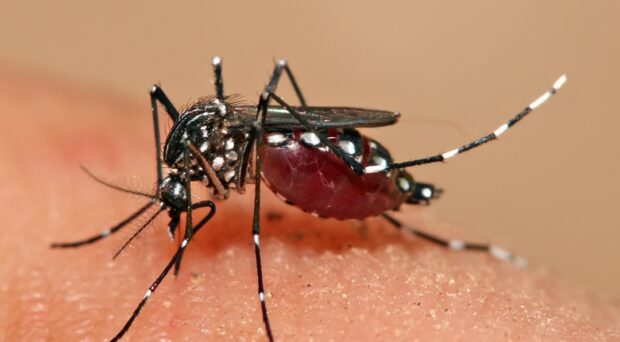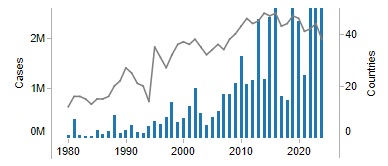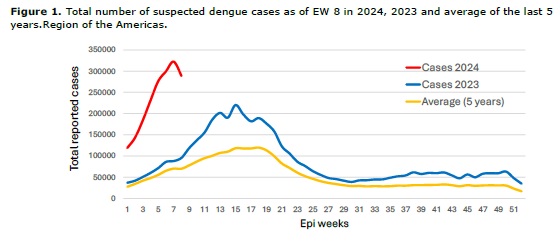
I was first introduced to mosquito-borne diseases 20 years ago this year, when Fred Gould at North Carolina State University took a chance to hire me, a new-fangled graduate student from Hungary with a PhD in Physics, as a postdoctoral researcher. I worked on a project focused on developing and extending mathematical models to simulate the population dynamics and genetics of the yellow fever mosquito, Aedes aegypti, and the potential for genetic methods to control the mosquito and the viruses it spreads. The targets were in particular the four closely related serotype of dengue viruses, that have a caused a staggering amount of 4.1 million cases of suspected dengue just in the Americas in 2023, according to the WHO. While up to 75% of cases of dengue are asymptomatic, or have “mild” symptoms such as fever and headache, 0.5% to 5% of cases develop severe dengue, including dengue hemorrhagic fever or dengue shock syndrome, which can have a fatality rate above 20% if untreated.

Unfortunately, while genetic control methods have been further developed since my time working as a postdoc, the threat of dengue has gotten much worse. The WHO documented a 10-fold surge in the last 20 years, the reported cases increasing globally from 500,000 in 2000 to 5.2 million in 2019. Most of the cases (80%) are reported from the Americas, where 500 million people are at risk of infection, and last year (2023) has seen another bumper year for the dengue viruses. Within the Americas, the largest number of cases in 2023 were reported in the Southern Cone region, particularly in Brazil with more than 3 million cases, although some other countries reported even higher incidence rates.

Sadly, it looks like 2024 might turn out to be an even worse year in terms of dengue. Just in the first 8 weeks of the year, WHO PAHO (the Pan-American Health Organization) is reporting close to 2 million suspected dengue cases, with almost 300,000 cases just in epidemiological week 8, which was February 18 to 24 this year. The vast majority (240,000) of those cases were in Brazil. These numbers are 2-3 times higher compared to even last year, and 4 times higher than the average in the last 5 years. All four serotypes of the dengue viruses are circulating, creating a hyperendemic situation, as few people are protected against all four serotypes from previous infections, and the risk of severe dengue increases with subsequent infections with different serotypes due to antibody-dependent enhancement. The number of cases is overwhelming the health system, and cases have been detected in areas of the country where dengue hasn’t been a problem before.

Some of these increases could be attributed to rising temperatures due to climate change. A recent article published in Scientific Reports found that high altitude regions that previously acted as barriers for disease transmission have become areas of high incidence rates. In the period 2007-13, the authors found a sharp decrease in incidence rates with increasing altitude, with hardly any cases reported above 1000 m altitude. However, by the period 2014-2020, dengue incidence rates substantially increased at every altitude above 400 m compared to the previous period, with the incidence rate above 1000 m becoming comparable to the frequency of infection at sea level. In addition to altitude, the article highlights the impact of temperature anomalies. The authors obtained the maximum temperature anomalies of each region and time period by checking if the maximum temperature exceeded the limits of what we should expect based on the 1981-2010 meteorological records. Between 2007-2013, such temperature anomalies were common in the Northeast and Southeast region of the country, but by the 2014-2020 period, most areas in the country suffered such anomalies, especially in the South and the Central-West part of the country. Simply said, it became that much hotter in a country that’s already hot in the summer. The authors also found that having more than 13 days of such temperature anomalies was positively associated with increased dengue incidence rate, as increased temperatures boost both mosquito reproduction and viral replication rates.
There are of course many other reasons, in addition to climate change, for the sudden surge of dengue in Brazil and the Americas in general. These include urbanization and the lack of effective mosquito control or specific treatments for dengue. Aedes aegypti is a notoriously difficult mosquito to control, and it is less efficient to control mosquito populations that are already infected with the virus. New genetic control methods are increasingly deployed and tested throughout the Americas and Brazil, and the World Mosquito Program is also deploying Wolbachia-infected mosquitoes to control dengue in several parts of the country. However, results can be patchy and dependent on local conditions. In Niterói, deployment of Wolbachia-infected mosquitoes has led to an amazing 69% reduction in dengue incidence, according to a 2021 study. However, in neighboring Rio de Janeiro, releases have only led to a 38% reduction in dengue incidence (which is still better than the increases going on now!). One potential explanation is that the wMel strain of Wolbachia is harder to introgress into the Aedes aegypti population in Rio. However, recent research also found that high titers of DENV-1 (one of the serotypes of dengue) can overwhelm the defenses Wolbachia provides for transmission, and makes even Wolbachia-infected mosquitoes able to transmit this serotype of the virus, although producing lower viral titer.
Recently developed dengue vaccines are also being deployed in Brazil, and the surge in new cases is spurring new research in vaccine and therapeutic development. Unfortunately, ramping up vaccine production to the scale required is difficult outside of the confines of global health emergencies such as the COVID-19 pandemic, so only a subset of the population is currently being vaccinated, serving as a starting point. We can only hope that a mixture of various mosquito control methods, vaccination and supportive therapy can limit the spread of dengue until the end of this mosquito season in the Americas, providing a brief respite to figure how to more effectively defeat the mosquito and these viruses before they come roaring back next season.

Comments